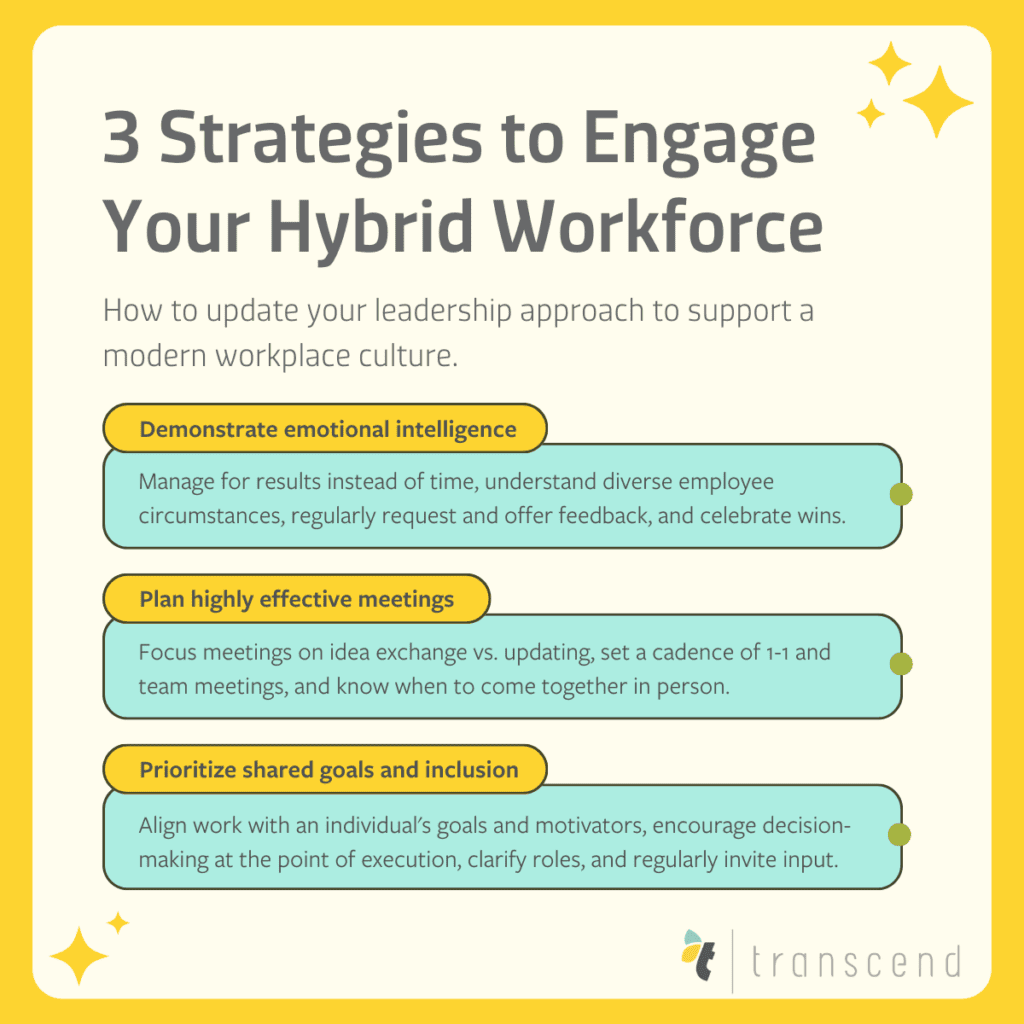
“The only constant in life is change.”
– Heraclitus, Greek philosopher
Change has been especially constant in the last few years of doing business, and we have found that the test of a successful leadership approach is whether it can live on through such change. With hybrid workplaces, flexible schedules, and leaders trying to assess what combination works best for them and their employees, it has become critical for companies to modernize their leadership approach to support the next evolution of business.
According to Gallup, 90% of remote-capable workers prefer some remote flexibility, making it clear that most industries will continue to look for some kind of balance between remote and in-office work. A recent LinkedIn article stated that the hybrid work model is expected to increase from 42% back in 2021, to what will soon be 81% in 2024. With this in mind, it’s time to examine legacy-era leadership approaches that may no longer serve whatever the “new normal” looks like for your business. Flawed organizational design, weak performance metrics, and outdated leadership mindsets must go.
Below, we’ll touch on three leadership competencies critical to virtual and hybrid environments and how, when aligned with modern leadership mindsets, they can drive collaboration and engagement across your organization.

Demonstrate emotional intelligence with a mindset shift.
Between being introduced into colleagues’ homes through the lens of Zoom meetings, to flexible and ever-changing in-office schedules, teams find themselves integrated into each other’s personal lives through hybrid work without the direct interactions they may have enjoyed when they were fully in-office. Thus, increasing the value of emotional intelligence to a non-negotiable standard of daily leadership.
According to the Gitnux Marketdata Report 2024, “Employees who believe that their leaders treat them with respect are 55% more engaged, 63% more satisfied, and 58% more focused on their jobs.” Leaders who do not adapt their emotional intelligence to the modern hybrid workplace will simply fail to retain talent.
Here are some tangible ways you can cultivate a trusting performance environment with heightened emotional intelligence:
- Manage for results, not structured hours on the clock. This means being flexible with meeting times and hours, as well as making a critical effort to align on shared expectations of team goals and productivity.
- Understand that people will have a diverse range of work environments and be sensitive to the challenges of this dynamic.
- Regularly request feedback from team members, actively listen, and be willing to shift when something isn’t working.
- Offer meaningful and frequent performance feedback, celebrate wins, and create opportunities for team growth through virtual venues.
Plan and align initiatives with highly effective meetings.
Heavy reliance on virtual meetings to connect and collaborate can inhibit productivity, leading to longer working hours and increased burnout. To improve performance, reevaluate your meeting processes and cadences. Increase their effectiveness by ensuring meetings spur engagement and alignment with your team.
Here are some ideas on streamlined processes that can increase productivity while bringing teams closer together.
- Take update meetings off the calendar. Meetings focused primarily on updates suck up time for high-value enterprise work. Find new ways to provide routine briefings and project management tracking that serve your team’s specific needs.
- Double down on meetings that focus on idea exchange and collaboration. Perspective sharing fosters a culture of excitement and gives people a sense of ownership around the shared mission.
- Create a cadence of one-on-one and team meetings that energize workers and give them a platform to share concerns and celebrate wins. Pairing the correct number of one-on-one connections with group meetings is both an art and a science. Find the combination that maximizes team and individual performance.
- Know when to come together. Humans naturally build stronger and more meaningful relationships when we see each other in person. Even if team members are all over the globe, make the investment to meet face-to-face at a pace that empowers strategy, execution, and team connection.
Drive engagement with shared goals and inclusion.
COVID necessitated an increase in centralized decision-making across organizations. It’s time to reverse that trend for the sake of an expanded sense of ownership and renewed trust in leadership. Give your team a voice by providing transparency into organizational strategy and include them in setting performance expectations. Here’s how:
- Structure work to align with an individual’s goals and motivators, drawing a clear line of connection to the goals of the organization.
- Encourage decision-making at the point of execution, which naturally empowers and amplifies the impact of their contributions.
- Regularly invite input, sharing ownership and visibility with the team. This includes celebrating wins, aligning on setbacks, and discussing future opportunities.
- Clarify roles and responsibilities. Each team member should be clear on why they are on the team and what they can do to drive a goal over the finish line.
The shift into a new era of business has come to bear. As it continues to settle and inevitably change, successful leaders will refresh their strategies and mindsets to engage their team and elevate performance, leaving antiquated techniques in the past. The principles of emotional intelligence, alignment, shared goals, and inclusion will always be present in winning teams. CEOs who adopt those tenets and invest in establishing modern leadership practices across their enterprise will capture an unparalleled competitive advantage in the years ahead.


